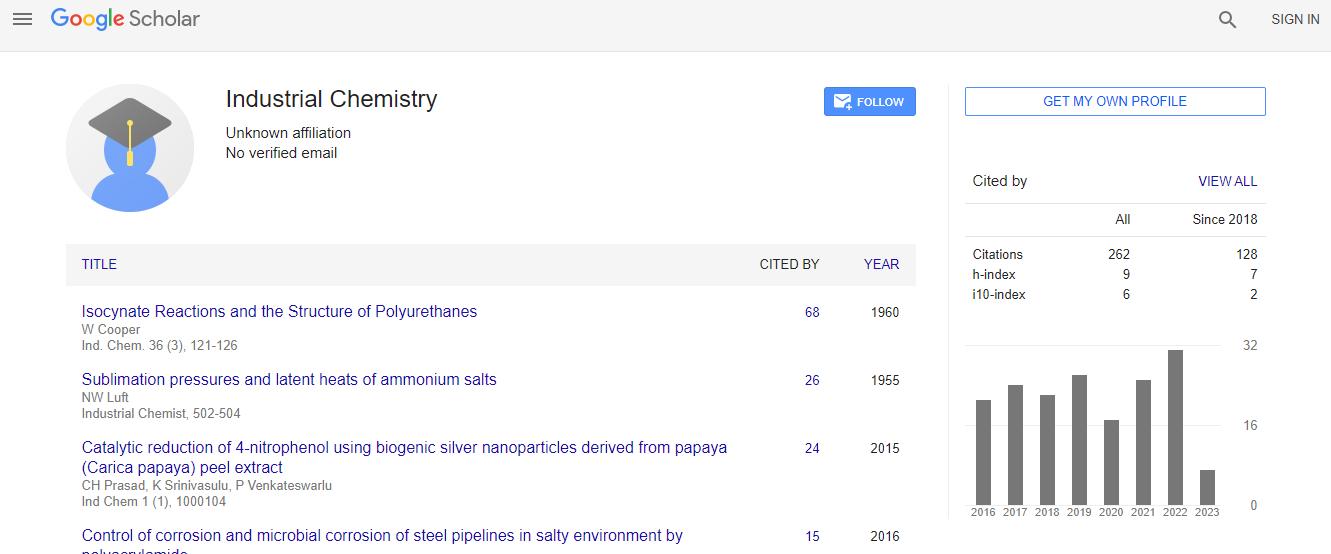Our Group organises 3000+ Global Conferenceseries Events every year across USA, Europe & Asia with support from 1000 more scientific Societies and Publishes 700+ Open Access Journals which contains over 50000 eminent personalities, reputed scientists as editorial board members.
Open Access Journals gaining more Readers and Citations
700 Journals and 15,000,000 Readers Each Journal is getting 25,000+ Readers
Google Scholar citation report
Citations : 262
Industrial Chemistry received 262 citations as per Google Scholar report
Indexed In
- Index Copernicus
- Google Scholar
- RefSeek
- Directory of Research Journal Indexing (DRJI)
- Hamdard University
- EBSCO A-Z
- OCLC- WorldCat
- Scholarsteer
- Geneva Foundation for Medical Education and Research
- Euro Pub
Useful Links
Recommended Journals
Related Subjects
Share This Page
Water Hyacinth: from threat to value-added product via HTC
2nd World Conference on Industrial Chemistry and Water Treatment
Silvia Roman, Beatriz Ledesma
University of Extremadura (UEX), Spain
Posters & Accepted Abstracts: Ind Chem
Abstract
Water Hyacinth (WH, Eichornia crassipes) is universally regarded as one of the more serious worldâ�?�?s invasive plants. Native from the Amazon river basin and introduced as an ornamental plant for water gardens, its rapid spreading has made this plant to be a major weed in many areas such as southern US states from Florida to California. WH tends to form mats on the water surface and can quickly dominate aquatic systems because of fast growing rate. WH causes problems for humans (navigable waterways obstruction, hydroelectric device fouling, blocking of irrigation channelsâ�?¦) and ecosystems (significant deterioration of water quality and severe harm to wildlife). In this work WH (leaves and stem) were subjected to hydrothermal carbonization (HTC) under varying experimental conditions (temperature, time and biomass/water ratio). This process has proven to be a cost effective green route to produce carbonaceous materials and offers many advantages including the possibility of using high moisture materials. The resulting hydrochars were characterized in terms of solid yield (SY, %), Heating Value (HHV, MJ kg-1) and surface properties (porosity, surface morphology and functionalities). It was found that SYs were very low owing to the high moisture content of the biomass (>99%). In general, longer HTC times, lower temperatures and greater biomass loads (even without water addition) involved greater values of SY. Temperature had the highest influence on HTC reactivity, promoting numerous degradation reactions. N2 adsorption analyses at 77 K indicated that all HCs had an incipient porosity, mainly located in the mesopore range, with low values of SBET (20-45 m2 g-1). Moreover, microspheres were observed from SEM analyses, as a result of polymerization of cellulose degradation products. The investigation of this invasive specie is of high interest; these results suggest that WH might be investigated for biofuel applications as well as for other used in the materials field, such as adsorption, energy storage or soil remediation. We are grateful for financial support provided by the Ministry of Economy and Competitiveness (MINECO) via project CTM2016-75937-RBiography
Silvia Román is associate professor at the University of Extremadura (Spain); her teaching includes subjects like technical thermodynamics and thermal engineering. Her research is focused on the use of wastes for energy via thermochemical processes as well as the production of porous materials for several applications. She has published more than 50 scientific papers on these topics and has patent on the production of activated carbon for radioiodine adsorption. During last years, she has been main the researcher of several funded projects on the hydrothermal conversion of biomass. She has recently been awarded with research and teaching recognition prizes such as “Excellence to young researcher career” and “teaching excellence”, both given by the University of Extremadura.
Email: sroman@unex.es

 Spanish
Spanish  Chinese
Chinese  Russian
Russian  German
German  French
French  Japanese
Japanese  Portuguese
Portuguese  Hindi
Hindi 